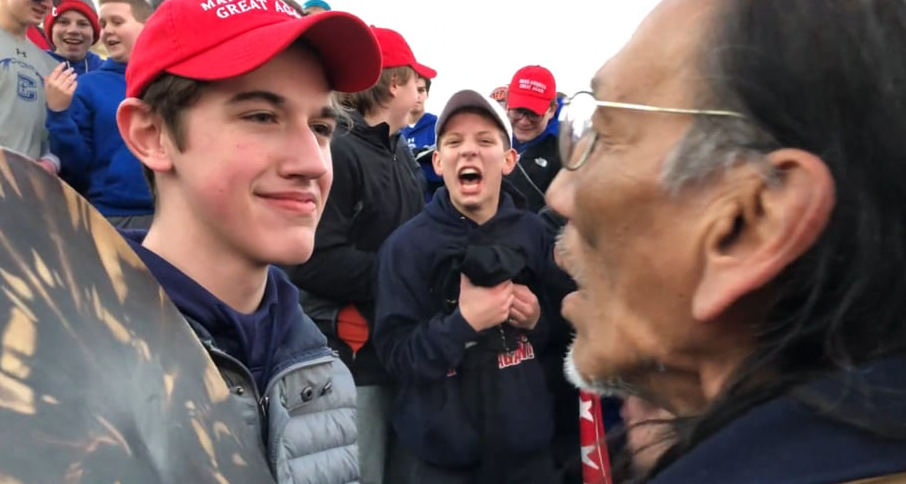Lincoln Memorial Clash Shows the Importance of Establishing the Facts

This weekend saw a powder keg of a crisis: the now-infamous incident in which a group of high school students appeared to confront and surround a smaller group of Native Americans at the Lincoln Memorial in Washington, D.C. The event is still bathed in confusion — which raises the issue of information gathering in a crisis.
The incident took place Friday, January 18. The students were in the capital for an anti-abortion March for Life event. The Native Americans were there for an Indigenous Peoples March.
The situation at first seemed clear-cut: the Kentucky-based students surrounded the indigenous group and mocked their singing, chanting, and drum beating. The focus was on one student in particular who stood smirking before an Indian elder. By Saturday, video of the ruckus had gone viral, and outrage spewed.
Then more video came out that “muddied” things to the point the episode has given rise to a “which side is right?” debate. It turns out the original confrontation was between the students and a small group of Black Hebrew Israelites, who were allegedly insulting everyone in hearing distance, including the teenagers. The students, from the all-male Covington Catholic High School in Park Hills, Kentucky, eventually started cheering and making noise to drown out the other side.
The elder, Nathan Phillips of the Omaha Nation, later said he got in between the two groups as he sang and pounded a drum to try to make peace (in other words, the students didn’t approach him). Now people rose to say this was all a rush to judgment that unfairly maligned the kids. Yet, the students (who are obviously not held to the standard of adults) did mock the Native Americans, including with tomahawk chops.
The cliff-hanging question was how the school would react. It was obviously a huge crisis for the institution. Over the weekend, it reportedly shut down all its social-media accounts. Its website couldn’t be accessed, possibly from too much traffic.
‘Church’s Teachings’
On Saturday, the Diocese of Covington and the school issued a joint statement. They condemned the students’ actions and apologized to Phillips and to the March for Life. “This behavior is opposed to the Church’s teachings on the dignity and respect of the human person,” they wrote. “The matter is being investigated and we will take appropriate action, up to and including expulsion.”
Yet it was probably too soon to condemn the students’ behavior; at that early stage, it would have been enough to note awareness of the problem, to announce the probe, and to express some sympathy. This incident, more than most, shows how hard it is to gather facts at the beginning of a crisis.
Most attention fell on the nearly 1,400-word statement Nick Sandmann, the student in the staredown (pictured) with Phillips, issued on Sunday through a lawyer (his family also hired a PR firm). All in all, the statement was too long, too lawyerly, and too defensive.
This behavior is opposed to the Church’s teachings on the dignity and respect of the human person.
— The Diocese of Covington and Covington Catholic High School
Sandmann said the students were shouting their school’s chants, implying they weren’t mocking Phillips and his co-demonstrators. He said he was smiling, not smirking, and trying to diffuse the situation by remaining calm. He clearly portrays himself as the victim.
“We had already been yelled at by another group of protestors, and when the second group approached I was worried that a situation was getting out of control where adults were attempting to provoke teenagers,” wrote Sandmann, who yesterday appeared on the Today show in aninterview some criticized as “softball.”
‘Like a Tinderbox’
Interestingly, representatives from the Indian tribes said they felt the same fear as Sandmann. “I was very concerned that it was going to get out of hand,” Chase Iron Eyes, a lawyer and spokesperson for the Indigenous Peoples March, told Amy Goodman on Democracy Now! “It was like a tinderbox.”
“I was absolutely afraid,” Phillips himself told Goodman. “There was a group of over 200 young angry white men who were displaying mob mentality.”
The Diocese closed the schoolTuesday “due to threats of violence,” though Native Americans say they didn’t threaten anyone.
The incident, which goes to the heart of today’s vast political divide in America, has grabbed the attention of many and will not subside soon. It’ll be interesting to see how the diocese and school continue to respond.
Meanwhile, both Phillips and Sandmann have said they are willing to talk to one another.
This is an abridged version of an article that appeared today on the CrisisResponsePro paid subscription portal. (CrisisResponsePro subscribers can access the full version by clicking here. ID and password are required.) To take advantage of all of the content, data, and collaborative resources CrisisResponsePro has to offer, contact us at signup@crisisresponsepro.com.




 Back to Blog
Back to Blog